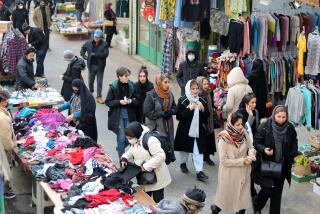Money Matters in Afghanistan
LONDON — While most of Europe will unite under a single currency in 2002, Afghanistan faces the new year with four separate ones, all called afghani and mostly counterfeit.
With the afghani trading, even at the highest-end official rate, at nearly 5,000 to the dollar, Afghanistan’s much-maligned money is not the most portable of currencies. And it represents a serious stumbling block to the government of national reconciliation, headed by Interim Prime Minister Hamid Karzai, which took office on Dec. 22 and will officially wield power for the next six months. Controlling the supply of afghani--or “afs,” as they are known--would be the first vital step toward bringing to heel the wayward warlords who have retaken power in most provinces of Afghanistan since the start of the U.S.-led bombing campaign against the Taliban last October.
Since 1996, with Russian help, Afghan warlords have counterfeited their national currency in bulk to pad out their treasuries and ensure an unremitting supply of local mercenaries to staff their private armies. The Northern Alliance, in particular, used access to the original currency printing plates as a tool of economic war in a bid to weaken the Taliban’s control of the country’s informal money markets.
Although Northern Alliance leaders have taken key portfolios in the transitional government, Karzai still needs to stabilize the afghani if it is to make the best use of the $7 billion to $9 billion in foreign aid expected to be committed at a donor conference for reconstruction to be held later this month in Tokyo.
The official money regulator, the Afghanistan National Bank (ANB), has not issued a new bill since the fall of Kabul to the Taliban and will be hard-pressed to impose any discipline on the three local and two international currencies that currently underpin what remains of the Afghan economy.
“There is only one solution,” said the ANB general secretary Ullah Mohammed Fayez recently, “To get rid of all the money in circulation and print new notes.” But a currency-exchange operation is unimaginable among a population that has dealt entirely in cash since the collapse of the communist regime of President Najibullah in 1992.
Few banks are open for business, and most Afghans live far beyond the reach of the radio announcements that would alert them to such any changeover in money. And while most merchants use the U.S. dollar or the Pakistani rupee to finance their import-dependent businesses, ordinary Afghans still depend upon the local currency for most of their transactions. To cancel the currency in one fell swoop would be to court a disaster of both public order and public well-being.
The Taliban’s connection to the afghani has always been odd. Taliban fighters stuffed the currency in their enemies’ mouths as a sign of contempt when they captured Kabul in 1996, then looted them by the truckload five years later when driven from the capital on Nov. 12. And while the movement professed to rule 90% of the country, its cash was almost entirely supplied by printers working in Russia for the Northern Alliance and the other opposition groups that controlled the remaining 10% of Afghanistan.
When the forces of ousted President Burhanuddin Rabbani were expelled by the Taliban from Kabul, they spirited away the printing plates to Russia. Whenever the U.N.-recognized President Rabbani needed money, to pay his men or to buy dollars on the informal markets that control the currency exchange business in the absence of a central bank, he simply sent word to his Russian printers to run off a fresh supply. This cash then trickled across the front lines to Taliban-controlled areas of the country, where it continued to be recognized as official tender.
When the Taliban attempted to crack down on the practice by banning post-1996 bills on the basis of their serial numbers, Rabbani’s printers manufactured new afghanis with pre-1996 numbers.
Consequently, there are now four versions of the currency in circulation, some with identical numbers, and all with varying rates of exchange. The first, considered the cream of the “old money” supply, dates from 1973 and bears a portrait of ex-king Mohammad Zaher Shah. Much in demand, it trades at a rate 15% stronger even than other “old bills.” A second set of “old bills” dates from before 1996 and is also considered “old money,” if not as valuable as the earlier bills. A third currency, “new money,” has higher serial numbers, originates in Russia and is worth less. A fourth set, produced by the Uzbek warlord Gen. Abdul Rashid Dostum to provide liquidity for his northern mini-state, also trade at a significant discount.
In spite of the fiscal disorder, money-changers can tell at a glance which of the different afghanis they are being asked to handle. Moreover, exchange rates in Kabul’s Shahzada currency market, a warren housing 300 different trading operations, fluctuate with confident precision, even though their market indicators come chiefly by cell phone or radio reports.
How long this byzantine, but ultimately free-market system can survive in the post-Taliban era remains to be seen. Shahzada’s traders have seen a sharp strengthening of the afghani since September on the promise of future aid and an avalanche of reconstruction funding.
While the lion’s share of the aid will be spent outside the country on relief food or new equipment for Afghanistan’s shattered infrastructure, a large sum will still percolate down to Shahzada and similar money markets as aid agencies seek to acquire afghanis to pay local salaries and suppliers.
The newly appointed finance minister in Karzai’s transitional government, Hedayat Amin Arsala, says he had received Russia’s assurances that it will henceforth only print currency orders from the Afghan central bank. But with the afghani strengthening daily, and untold quantities under lock and key in the fortresses of local warlords, it’s anyone’s guess just how long that confident agreement will last.
*
Michael Griffin is author of “Reaping the Whirlwind: The Taliban in Afghanistan.”
More to Read
Sign up for Essential California
The most important California stories and recommendations in your inbox every morning.
You may occasionally receive promotional content from the Los Angeles Times.










